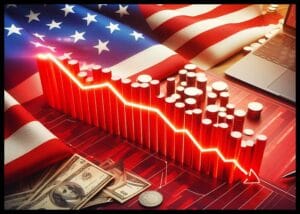Has the US economy improved or deteriorated since Trump took office?

The Biden-Harris government has destroyed the “greatest economy in the history of our country,” according to Trump, the Republican contender and former president.
To evaluate the economic success of the two presidencies, we have examined a few important metrics.
US economic expansion
Let’s start by examining economic growth using GDP, which is the total worth of all commodities and services in the US economy. Both presidents may point to some noteworthy economic achievements, even though the effects of COVID have made comparisons challenging. This is because wages have been unable to keep up with price rises in recent years. Due to the closure of numerous firms during COVID-19, this number drastically fell.
Trump led the economy to a robust recovery after the outbreak, outperforming many other Western nations in the process.
Under Mr. Biden, this has persisted, and according to GDP, the US has produced the strongest epidemic recovery among the G7. An average yearly growth rate of 2.3% was seen from January 2017 and January 2021.
This time frame encompasses the economic downturn and recovery brought on by the COVID-19 epidemic.
This percentage is 2.2% under the Biden administration, which is nearly the same.
Under both Trump and Biden, there have been times in the past, like the 1970s, when GDP growth was noticeably faster than the norm.
The rate of inflation
One of the campaign’s main concerns has been the rate of price increases.
The first two years under Mr. Biden saw a sharp increase in prices, which peaked in June 2022 at 9.1%. Inflation has been significantly higher than that at various previous times in US history, with the last time it was above 9% occurring in 1981.
Although it has now decreased to about 3%, inflation is still higher than it was before Trump left office.
For instance, the cost of groceries rose 13.5% in the year that ended in August 2022.
The cost of goods increased by 1.1% between July 2023 and July of this year, marking the peak of pricing during the Biden administration. Since then, prices have largely stabilized.
Employment
Strong job growth has been cited by the Biden administration as a key accomplishment on numerous occasions.
In the first three years of Trump’s presidency, about 6.7 million jobs were created, according to data for non-farm jobs (which employ around 80% of the labor force) before significant job losses in 2020 as a result of COVID-19.
If Trump had won in 2020, many of the jobs would have returned, but the American Rescue Plan was a crucial factor in the labor market’s rapid and forceful recovery, according to Georgetown University economist Professor Mark Strain.
In 2021, the Biden government passed this spending package with the intention of boosting the economy after the pandemic.
Businesses prepare on Tuesday as they discuss the election rise during earnings calls.
Unlike previous cycles, executives at the biggest firms in America are discussing the presidential race in public with investors. As they cast their ballots in what is expected to be a close contest between Donald Trump and Kamala Harris, regular Americans are thinking about the economy.
Meanwhile, white-collar executives are thinking about how policies can affect their companies and complaining about a general sense of unpredictability associated with the election season. The number of businesses talking about elections in recent weeks was initially noted by John Butters, a senior earnings analyst at FactSet. Notably, his research revealed that hardly any S&P 500 company executives specifically addressed Trump or Harris.
“Shrewd” customers
CEO Harry Lawton of Tractor Supply stated that the company’s customers were expected to continue being “prudent,” similar to previous election years. This comes after emergency response sales increased at the beginning of the quarter after Hurricanes Helene and Milton, according to the farm-focused retailer.
Along with Election Day, market players and corporate executives are also keeping a careful eye on the Federal Reserve’s monetary policy meeting the following week. Manufacturer of tools Stanley Black & Decker
According to CEO Donald Allan, there would be “choppy markets” into the first half of 2025 due to the election and interest rates.
The election is one of the factors causing a “little bit of a pause” in the industrial market for large projects, according to William Grogan, CFO of water infrastructure giant Xylem. Despite experiencing “a little bit of paralysis in an election year,” Republic Services CEO Jon Vander Ark expressed optimism for the company as it approaches the conclusion of 2024 and the beginning of 2025.
Keeping an eye on the economy

Due to hurricanes and the Boeing strike, nonfarm payrolls increased by the fewest positions in October compared to late 2020. Accordingly, Equifax
claimed to have observed a decline in the number of background checks as executives thought about the potential consequences for their companies.
Going ahead
Nevertheless, it seems that a remarkably high number of executives from the biggest companies in corporate America are involved in this cycle. The number of 2024 mentions corresponds to the term “election” being on the calls of almost one out of every five S&P 500 businesses during that period.
Additionally, there are more than three times as many references as there were in 2008.Paul Romanowski, CEO of D.R. Horton, claims that because of the stress associated with the election and the prospect of lower mortgage rates in 2025, purchasers are “staying on the sidelines.” According to him, the homebuilder is concentrating on creating homes with smaller floor plans and providing mortgage buydowns to increase demand.
